Alexandra's Case: Framework for Type 1 Diabetes Treatment Analysis
VerifiedAdded on 2023/01/16
|11
|3707
|100
Report
AI Summary
This report provides a detailed analysis of Alexandra's case of Type 1 diabetes. It begins with an introduction that highlights the increasing prevalence of the condition and the transition from young to adult care. The main body critically discusses the nursing framework for treating Alexandra, focusing on the NMC principles, particularly 'Prioritize People,' and the importance of balancing patient autonomy with parental involvement. It outlines the pathophysiology of Type 1 diabetes, explaining the destruction of beta cells and the need for exogenous insulin. The report also explores the psychological and social impacts on Alexandra, including the effects of the transition to adult care and the importance of peer support. Furthermore, it examines the assessment and clinical decision-making processes, referencing NICE guidelines and the importance of patient-centered care. Finally, the report addresses the elements of risk and safeguarding concerns related to Alexandra's treatment, such as the consequences of missed insulin dosages.

KINGTON EXAM
Paraphrase This Document
Need a fresh take? Get an instant paraphrase of this document with our AI Paraphraser
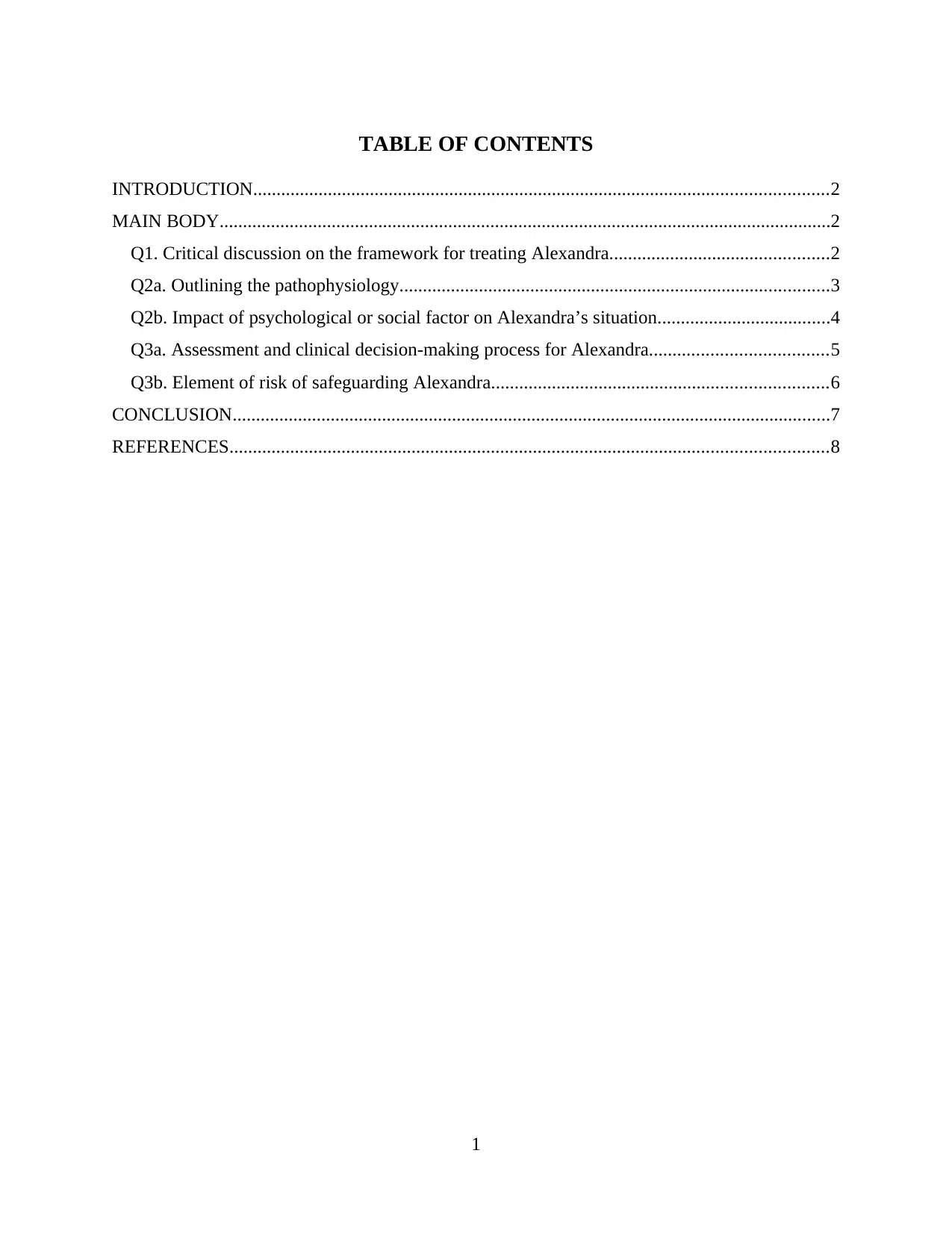
TABLE OF CONTENTS
INTRODUCTION...........................................................................................................................2
MAIN BODY...................................................................................................................................2
Q1. Critical discussion on the framework for treating Alexandra...............................................2
Q2a. Outlining the pathophysiology............................................................................................3
Q2b. Impact of psychological or social factor on Alexandra’s situation.....................................4
Q3a. Assessment and clinical decision-making process for Alexandra......................................5
Q3b. Element of risk of safeguarding Alexandra........................................................................6
CONCLUSION................................................................................................................................7
REFERENCES................................................................................................................................8
1
INTRODUCTION...........................................................................................................................2
MAIN BODY...................................................................................................................................2
Q1. Critical discussion on the framework for treating Alexandra...............................................2
Q2a. Outlining the pathophysiology............................................................................................3
Q2b. Impact of psychological or social factor on Alexandra’s situation.....................................4
Q3a. Assessment and clinical decision-making process for Alexandra......................................5
Q3b. Element of risk of safeguarding Alexandra........................................................................6
CONCLUSION................................................................................................................................7
REFERENCES................................................................................................................................8
1
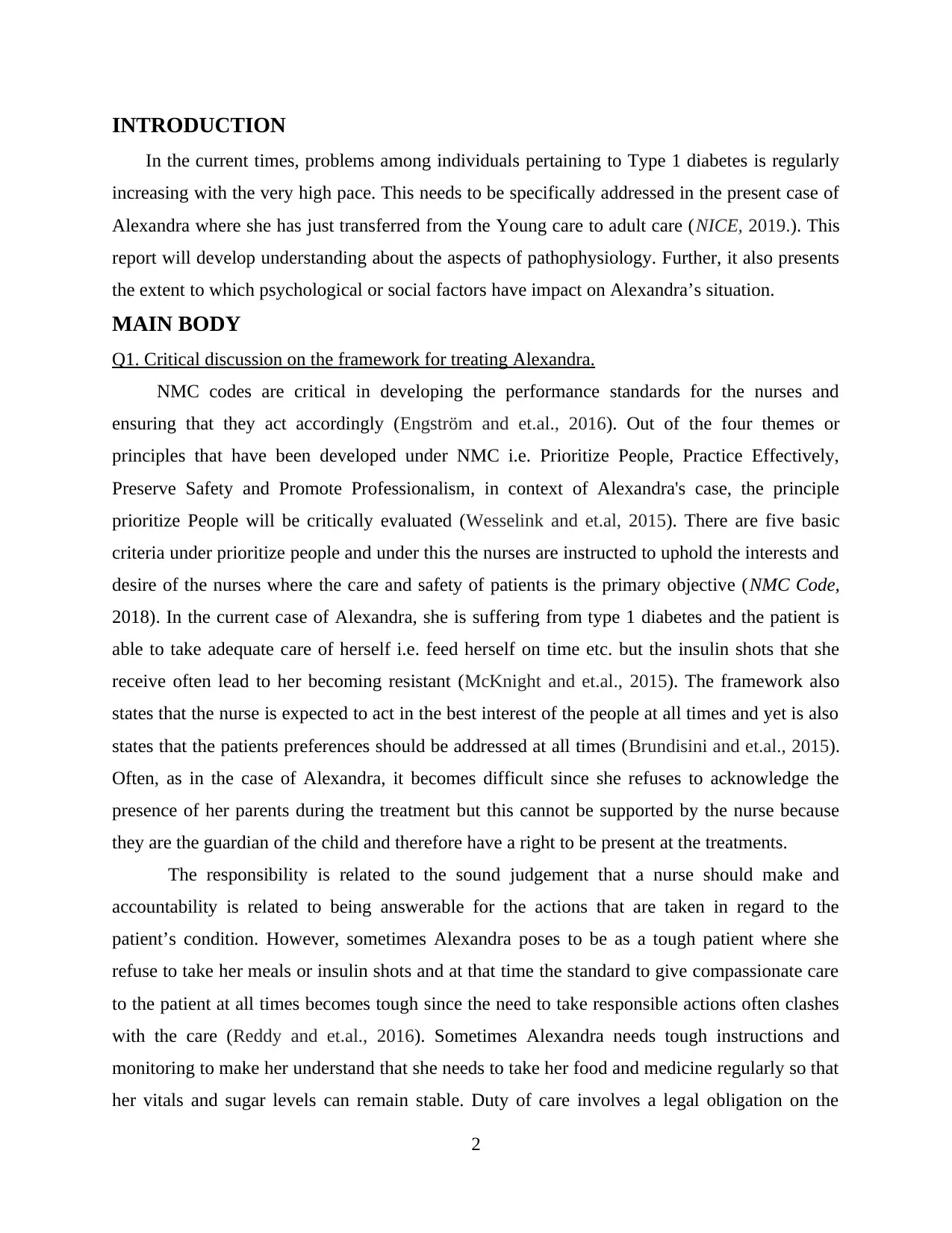
INTRODUCTION
In the current times, problems among individuals pertaining to Type 1 diabetes is regularly
increasing with the very high pace. This needs to be specifically addressed in the present case of
Alexandra where she has just transferred from the Young care to adult care (NICE, 2019.). This
report will develop understanding about the aspects of pathophysiology. Further, it also presents
the extent to which psychological or social factors have impact on Alexandra’s situation.
MAIN BODY
Q1. Critical discussion on the framework for treating Alexandra.
NMC codes are critical in developing the performance standards for the nurses and
ensuring that they act accordingly (Engström and et.al., 2016). Out of the four themes or
principles that have been developed under NMC i.e. Prioritize People, Practice Effectively,
Preserve Safety and Promote Professionalism, in context of Alexandra's case, the principle
prioritize People will be critically evaluated (Wesselink and et.al, 2015). There are five basic
criteria under prioritize people and under this the nurses are instructed to uphold the interests and
desire of the nurses where the care and safety of patients is the primary objective (NMC Code,
2018). In the current case of Alexandra, she is suffering from type 1 diabetes and the patient is
able to take adequate care of herself i.e. feed herself on time etc. but the insulin shots that she
receive often lead to her becoming resistant (McKnight and et.al., 2015). The framework also
states that the nurse is expected to act in the best interest of the people at all times and yet is also
states that the patients preferences should be addressed at all times (Brundisini and et.al., 2015).
Often, as in the case of Alexandra, it becomes difficult since she refuses to acknowledge the
presence of her parents during the treatment but this cannot be supported by the nurse because
they are the guardian of the child and therefore have a right to be present at the treatments.
The responsibility is related to the sound judgement that a nurse should make and
accountability is related to being answerable for the actions that are taken in regard to the
patient’s condition. However, sometimes Alexandra poses to be as a tough patient where she
refuse to take her meals or insulin shots and at that time the standard to give compassionate care
to the patient at all times becomes tough since the need to take responsible actions often clashes
with the care (Reddy and et.al., 2016). Sometimes Alexandra needs tough instructions and
monitoring to make her understand that she needs to take her food and medicine regularly so that
her vitals and sugar levels can remain stable. Duty of care involves a legal obligation on the
2
In the current times, problems among individuals pertaining to Type 1 diabetes is regularly
increasing with the very high pace. This needs to be specifically addressed in the present case of
Alexandra where she has just transferred from the Young care to adult care (NICE, 2019.). This
report will develop understanding about the aspects of pathophysiology. Further, it also presents
the extent to which psychological or social factors have impact on Alexandra’s situation.
MAIN BODY
Q1. Critical discussion on the framework for treating Alexandra.
NMC codes are critical in developing the performance standards for the nurses and
ensuring that they act accordingly (Engström and et.al., 2016). Out of the four themes or
principles that have been developed under NMC i.e. Prioritize People, Practice Effectively,
Preserve Safety and Promote Professionalism, in context of Alexandra's case, the principle
prioritize People will be critically evaluated (Wesselink and et.al, 2015). There are five basic
criteria under prioritize people and under this the nurses are instructed to uphold the interests and
desire of the nurses where the care and safety of patients is the primary objective (NMC Code,
2018). In the current case of Alexandra, she is suffering from type 1 diabetes and the patient is
able to take adequate care of herself i.e. feed herself on time etc. but the insulin shots that she
receive often lead to her becoming resistant (McKnight and et.al., 2015). The framework also
states that the nurse is expected to act in the best interest of the people at all times and yet is also
states that the patients preferences should be addressed at all times (Brundisini and et.al., 2015).
Often, as in the case of Alexandra, it becomes difficult since she refuses to acknowledge the
presence of her parents during the treatment but this cannot be supported by the nurse because
they are the guardian of the child and therefore have a right to be present at the treatments.
The responsibility is related to the sound judgement that a nurse should make and
accountability is related to being answerable for the actions that are taken in regard to the
patient’s condition. However, sometimes Alexandra poses to be as a tough patient where she
refuse to take her meals or insulin shots and at that time the standard to give compassionate care
to the patient at all times becomes tough since the need to take responsible actions often clashes
with the care (Reddy and et.al., 2016). Sometimes Alexandra needs tough instructions and
monitoring to make her understand that she needs to take her food and medicine regularly so that
her vitals and sugar levels can remain stable. Duty of care involves a legal obligation on the
2
⊘ This is a preview!⊘
Do you want full access?
Subscribe today to unlock all pages.

Trusted by 1+ million students worldwide
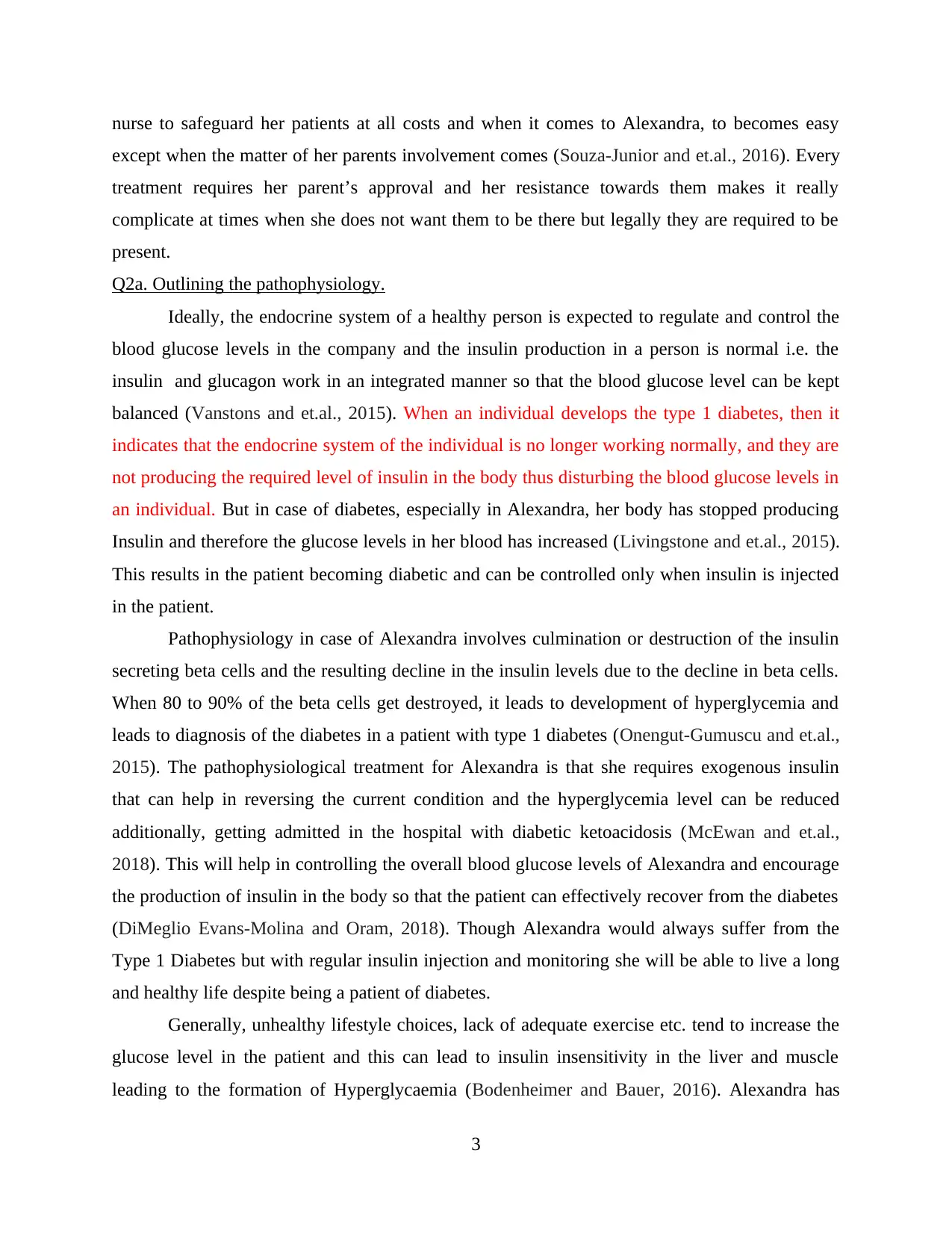
nurse to safeguard her patients at all costs and when it comes to Alexandra, to becomes easy
except when the matter of her parents involvement comes (Souza-Junior and et.al., 2016). Every
treatment requires her parent’s approval and her resistance towards them makes it really
complicate at times when she does not want them to be there but legally they are required to be
present.
Q2a. Outlining the pathophysiology.
Ideally, the endocrine system of a healthy person is expected to regulate and control the
blood glucose levels in the company and the insulin production in a person is normal i.e. the
insulin and glucagon work in an integrated manner so that the blood glucose level can be kept
balanced (Vanstons and et.al., 2015). When an individual develops the type 1 diabetes, then it
indicates that the endocrine system of the individual is no longer working normally, and they are
not producing the required level of insulin in the body thus disturbing the blood glucose levels in
an individual. But in case of diabetes, especially in Alexandra, her body has stopped producing
Insulin and therefore the glucose levels in her blood has increased (Livingstone and et.al., 2015).
This results in the patient becoming diabetic and can be controlled only when insulin is injected
in the patient.
Pathophysiology in case of Alexandra involves culmination or destruction of the insulin
secreting beta cells and the resulting decline in the insulin levels due to the decline in beta cells.
When 80 to 90% of the beta cells get destroyed, it leads to development of hyperglycemia and
leads to diagnosis of the diabetes in a patient with type 1 diabetes (Onengut-Gumuscu and et.al.,
2015). The pathophysiological treatment for Alexandra is that she requires exogenous insulin
that can help in reversing the current condition and the hyperglycemia level can be reduced
additionally, getting admitted in the hospital with diabetic ketoacidosis (McEwan and et.al.,
2018). This will help in controlling the overall blood glucose levels of Alexandra and encourage
the production of insulin in the body so that the patient can effectively recover from the diabetes
(DiMeglio Evans-Molina and Oram, 2018). Though Alexandra would always suffer from the
Type 1 Diabetes but with regular insulin injection and monitoring she will be able to live a long
and healthy life despite being a patient of diabetes.
Generally, unhealthy lifestyle choices, lack of adequate exercise etc. tend to increase the
glucose level in the patient and this can lead to insulin insensitivity in the liver and muscle
leading to the formation of Hyperglycaemia (Bodenheimer and Bauer, 2016). Alexandra has
3
except when the matter of her parents involvement comes (Souza-Junior and et.al., 2016). Every
treatment requires her parent’s approval and her resistance towards them makes it really
complicate at times when she does not want them to be there but legally they are required to be
present.
Q2a. Outlining the pathophysiology.
Ideally, the endocrine system of a healthy person is expected to regulate and control the
blood glucose levels in the company and the insulin production in a person is normal i.e. the
insulin and glucagon work in an integrated manner so that the blood glucose level can be kept
balanced (Vanstons and et.al., 2015). When an individual develops the type 1 diabetes, then it
indicates that the endocrine system of the individual is no longer working normally, and they are
not producing the required level of insulin in the body thus disturbing the blood glucose levels in
an individual. But in case of diabetes, especially in Alexandra, her body has stopped producing
Insulin and therefore the glucose levels in her blood has increased (Livingstone and et.al., 2015).
This results in the patient becoming diabetic and can be controlled only when insulin is injected
in the patient.
Pathophysiology in case of Alexandra involves culmination or destruction of the insulin
secreting beta cells and the resulting decline in the insulin levels due to the decline in beta cells.
When 80 to 90% of the beta cells get destroyed, it leads to development of hyperglycemia and
leads to diagnosis of the diabetes in a patient with type 1 diabetes (Onengut-Gumuscu and et.al.,
2015). The pathophysiological treatment for Alexandra is that she requires exogenous insulin
that can help in reversing the current condition and the hyperglycemia level can be reduced
additionally, getting admitted in the hospital with diabetic ketoacidosis (McEwan and et.al.,
2018). This will help in controlling the overall blood glucose levels of Alexandra and encourage
the production of insulin in the body so that the patient can effectively recover from the diabetes
(DiMeglio Evans-Molina and Oram, 2018). Though Alexandra would always suffer from the
Type 1 Diabetes but with regular insulin injection and monitoring she will be able to live a long
and healthy life despite being a patient of diabetes.
Generally, unhealthy lifestyle choices, lack of adequate exercise etc. tend to increase the
glucose level in the patient and this can lead to insulin insensitivity in the liver and muscle
leading to the formation of Hyperglycaemia (Bodenheimer and Bauer, 2016). Alexandra has
3
Paraphrase This Document
Need a fresh take? Get an instant paraphrase of this document with our AI Paraphraser
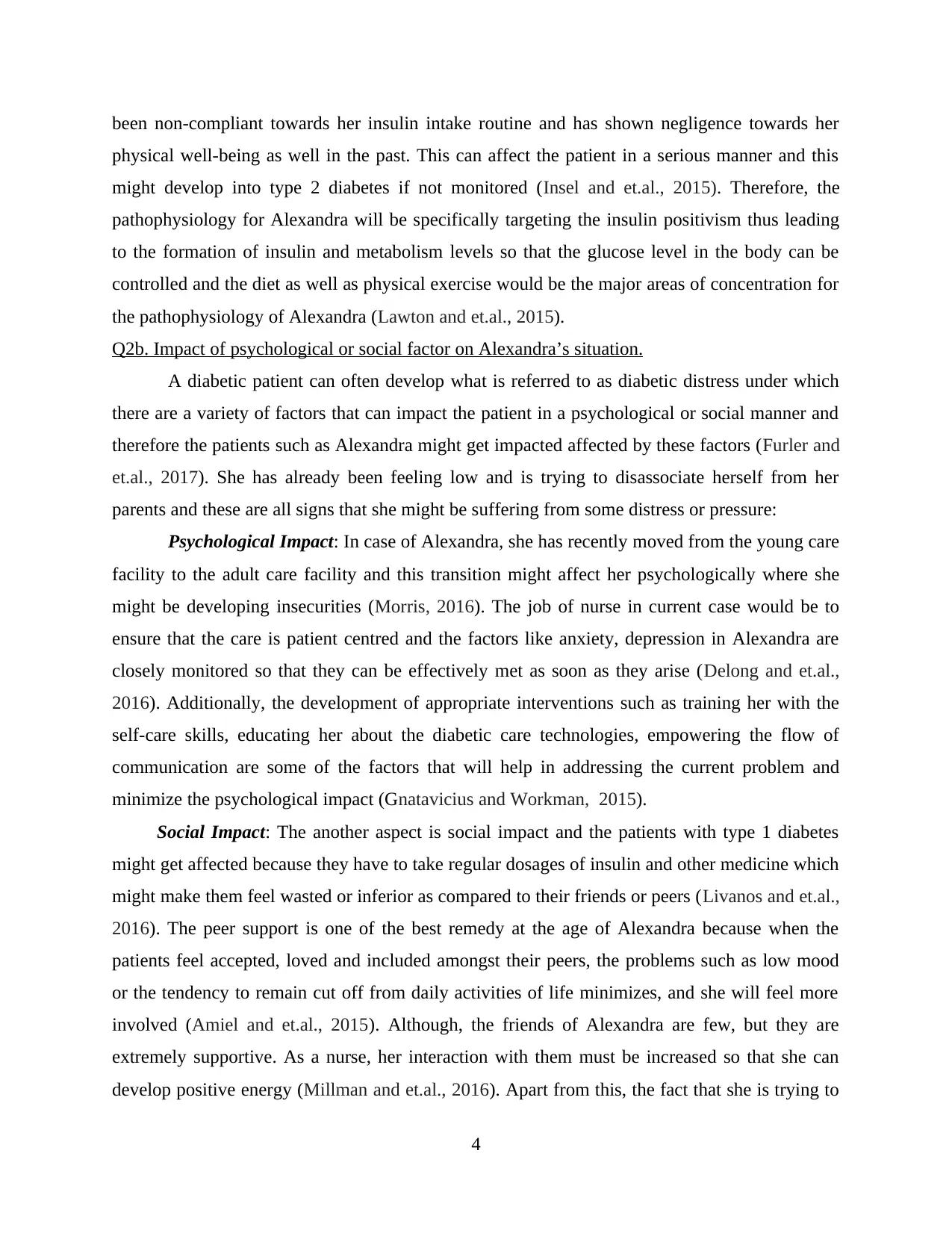
been non-compliant towards her insulin intake routine and has shown negligence towards her
physical well-being as well in the past. This can affect the patient in a serious manner and this
might develop into type 2 diabetes if not monitored (Insel and et.al., 2015). Therefore, the
pathophysiology for Alexandra will be specifically targeting the insulin positivism thus leading
to the formation of insulin and metabolism levels so that the glucose level in the body can be
controlled and the diet as well as physical exercise would be the major areas of concentration for
the pathophysiology of Alexandra (Lawton and et.al., 2015).
Q2b. Impact of psychological or social factor on Alexandra’s situation.
A diabetic patient can often develop what is referred to as diabetic distress under which
there are a variety of factors that can impact the patient in a psychological or social manner and
therefore the patients such as Alexandra might get impacted affected by these factors (Furler and
et.al., 2017). She has already been feeling low and is trying to disassociate herself from her
parents and these are all signs that she might be suffering from some distress or pressure:
Psychological Impact: In case of Alexandra, she has recently moved from the young care
facility to the adult care facility and this transition might affect her psychologically where she
might be developing insecurities (Morris, 2016). The job of nurse in current case would be to
ensure that the care is patient centred and the factors like anxiety, depression in Alexandra are
closely monitored so that they can be effectively met as soon as they arise (Delong and et.al.,
2016). Additionally, the development of appropriate interventions such as training her with the
self-care skills, educating her about the diabetic care technologies, empowering the flow of
communication are some of the factors that will help in addressing the current problem and
minimize the psychological impact (Gnatavicius and Workman, 2015).
Social Impact: The another aspect is social impact and the patients with type 1 diabetes
might get affected because they have to take regular dosages of insulin and other medicine which
might make them feel wasted or inferior as compared to their friends or peers (Livanos and et.al.,
2016). The peer support is one of the best remedy at the age of Alexandra because when the
patients feel accepted, loved and included amongst their peers, the problems such as low mood
or the tendency to remain cut off from daily activities of life minimizes, and she will feel more
involved (Amiel and et.al., 2015). Although, the friends of Alexandra are few, but they are
extremely supportive. As a nurse, her interaction with them must be increased so that she can
develop positive energy (Millman and et.al., 2016). Apart from this, the fact that she is trying to
4
physical well-being as well in the past. This can affect the patient in a serious manner and this
might develop into type 2 diabetes if not monitored (Insel and et.al., 2015). Therefore, the
pathophysiology for Alexandra will be specifically targeting the insulin positivism thus leading
to the formation of insulin and metabolism levels so that the glucose level in the body can be
controlled and the diet as well as physical exercise would be the major areas of concentration for
the pathophysiology of Alexandra (Lawton and et.al., 2015).
Q2b. Impact of psychological or social factor on Alexandra’s situation.
A diabetic patient can often develop what is referred to as diabetic distress under which
there are a variety of factors that can impact the patient in a psychological or social manner and
therefore the patients such as Alexandra might get impacted affected by these factors (Furler and
et.al., 2017). She has already been feeling low and is trying to disassociate herself from her
parents and these are all signs that she might be suffering from some distress or pressure:
Psychological Impact: In case of Alexandra, she has recently moved from the young care
facility to the adult care facility and this transition might affect her psychologically where she
might be developing insecurities (Morris, 2016). The job of nurse in current case would be to
ensure that the care is patient centred and the factors like anxiety, depression in Alexandra are
closely monitored so that they can be effectively met as soon as they arise (Delong and et.al.,
2016). Additionally, the development of appropriate interventions such as training her with the
self-care skills, educating her about the diabetic care technologies, empowering the flow of
communication are some of the factors that will help in addressing the current problem and
minimize the psychological impact (Gnatavicius and Workman, 2015).
Social Impact: The another aspect is social impact and the patients with type 1 diabetes
might get affected because they have to take regular dosages of insulin and other medicine which
might make them feel wasted or inferior as compared to their friends or peers (Livanos and et.al.,
2016). The peer support is one of the best remedy at the age of Alexandra because when the
patients feel accepted, loved and included amongst their peers, the problems such as low mood
or the tendency to remain cut off from daily activities of life minimizes, and she will feel more
involved (Amiel and et.al., 2015). Although, the friends of Alexandra are few, but they are
extremely supportive. As a nurse, her interaction with them must be increased so that she can
develop positive energy (Millman and et.al., 2016). Apart from this, the fact that she is trying to
4
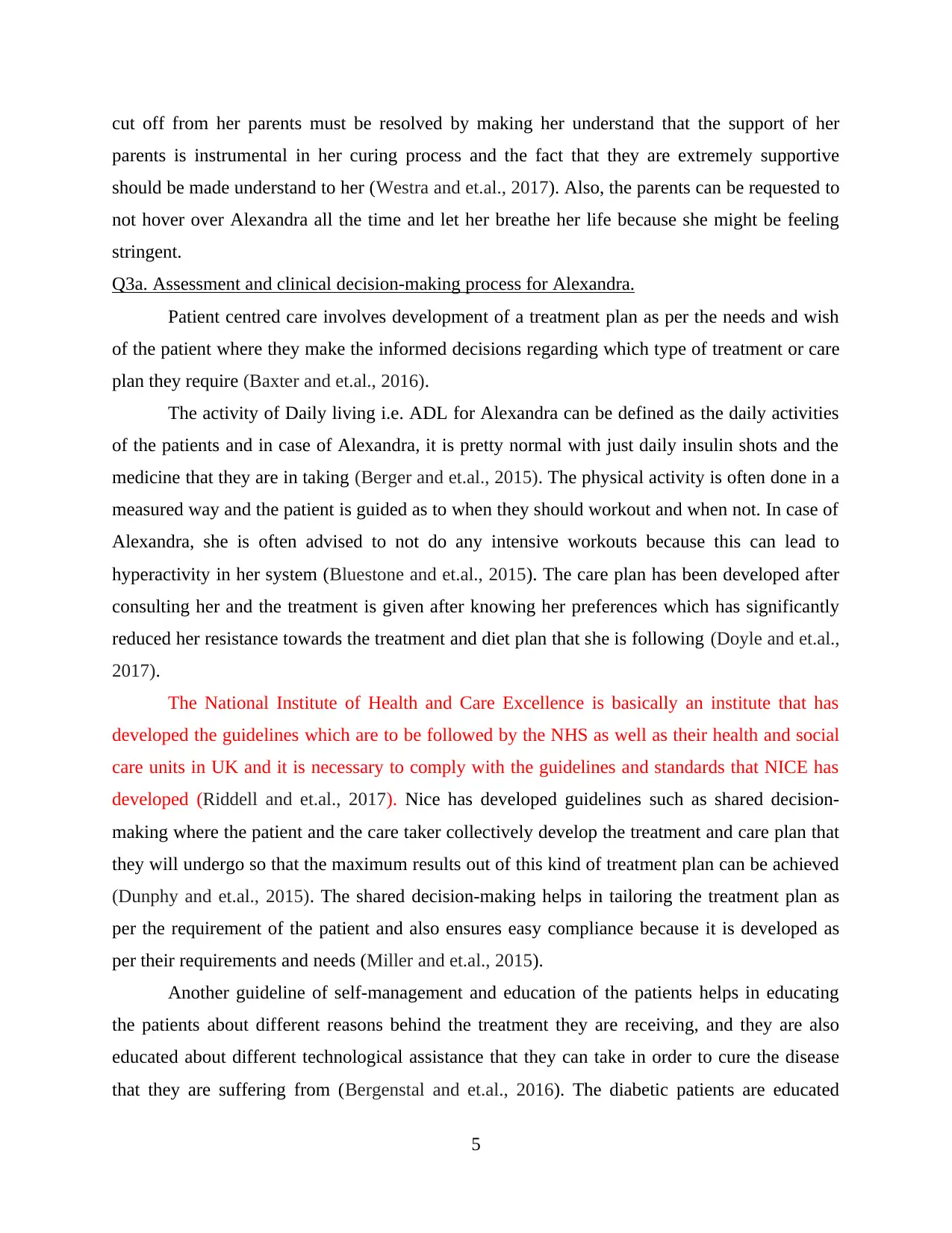
cut off from her parents must be resolved by making her understand that the support of her
parents is instrumental in her curing process and the fact that they are extremely supportive
should be made understand to her (Westra and et.al., 2017). Also, the parents can be requested to
not hover over Alexandra all the time and let her breathe her life because she might be feeling
stringent.
Q3a. Assessment and clinical decision-making process for Alexandra.
Patient centred care involves development of a treatment plan as per the needs and wish
of the patient where they make the informed decisions regarding which type of treatment or care
plan they require (Baxter and et.al., 2016).
The activity of Daily living i.e. ADL for Alexandra can be defined as the daily activities
of the patients and in case of Alexandra, it is pretty normal with just daily insulin shots and the
medicine that they are in taking (Berger and et.al., 2015). The physical activity is often done in a
measured way and the patient is guided as to when they should workout and when not. In case of
Alexandra, she is often advised to not do any intensive workouts because this can lead to
hyperactivity in her system (Bluestone and et.al., 2015). The care plan has been developed after
consulting her and the treatment is given after knowing her preferences which has significantly
reduced her resistance towards the treatment and diet plan that she is following (Doyle and et.al.,
2017).
The National Institute of Health and Care Excellence is basically an institute that has
developed the guidelines which are to be followed by the NHS as well as their health and social
care units in UK and it is necessary to comply with the guidelines and standards that NICE has
developed (Riddell and et.al., 2017). Nice has developed guidelines such as shared decision-
making where the patient and the care taker collectively develop the treatment and care plan that
they will undergo so that the maximum results out of this kind of treatment plan can be achieved
(Dunphy and et.al., 2015). The shared decision-making helps in tailoring the treatment plan as
per the requirement of the patient and also ensures easy compliance because it is developed as
per their requirements and needs (Miller and et.al., 2015).
Another guideline of self-management and education of the patients helps in educating
the patients about different reasons behind the treatment they are receiving, and they are also
educated about different technological assistance that they can take in order to cure the disease
that they are suffering from (Bergenstal and et.al., 2016). The diabetic patients are educated
5
parents is instrumental in her curing process and the fact that they are extremely supportive
should be made understand to her (Westra and et.al., 2017). Also, the parents can be requested to
not hover over Alexandra all the time and let her breathe her life because she might be feeling
stringent.
Q3a. Assessment and clinical decision-making process for Alexandra.
Patient centred care involves development of a treatment plan as per the needs and wish
of the patient where they make the informed decisions regarding which type of treatment or care
plan they require (Baxter and et.al., 2016).
The activity of Daily living i.e. ADL for Alexandra can be defined as the daily activities
of the patients and in case of Alexandra, it is pretty normal with just daily insulin shots and the
medicine that they are in taking (Berger and et.al., 2015). The physical activity is often done in a
measured way and the patient is guided as to when they should workout and when not. In case of
Alexandra, she is often advised to not do any intensive workouts because this can lead to
hyperactivity in her system (Bluestone and et.al., 2015). The care plan has been developed after
consulting her and the treatment is given after knowing her preferences which has significantly
reduced her resistance towards the treatment and diet plan that she is following (Doyle and et.al.,
2017).
The National Institute of Health and Care Excellence is basically an institute that has
developed the guidelines which are to be followed by the NHS as well as their health and social
care units in UK and it is necessary to comply with the guidelines and standards that NICE has
developed (Riddell and et.al., 2017). Nice has developed guidelines such as shared decision-
making where the patient and the care taker collectively develop the treatment and care plan that
they will undergo so that the maximum results out of this kind of treatment plan can be achieved
(Dunphy and et.al., 2015). The shared decision-making helps in tailoring the treatment plan as
per the requirement of the patient and also ensures easy compliance because it is developed as
per their requirements and needs (Miller and et.al., 2015).
Another guideline of self-management and education of the patients helps in educating
the patients about different reasons behind the treatment they are receiving, and they are also
educated about different technological assistance that they can take in order to cure the disease
that they are suffering from (Bergenstal and et.al., 2016). The diabetic patients are educated
5
⊘ This is a preview!⊘
Do you want full access?
Subscribe today to unlock all pages.

Trusted by 1+ million students worldwide
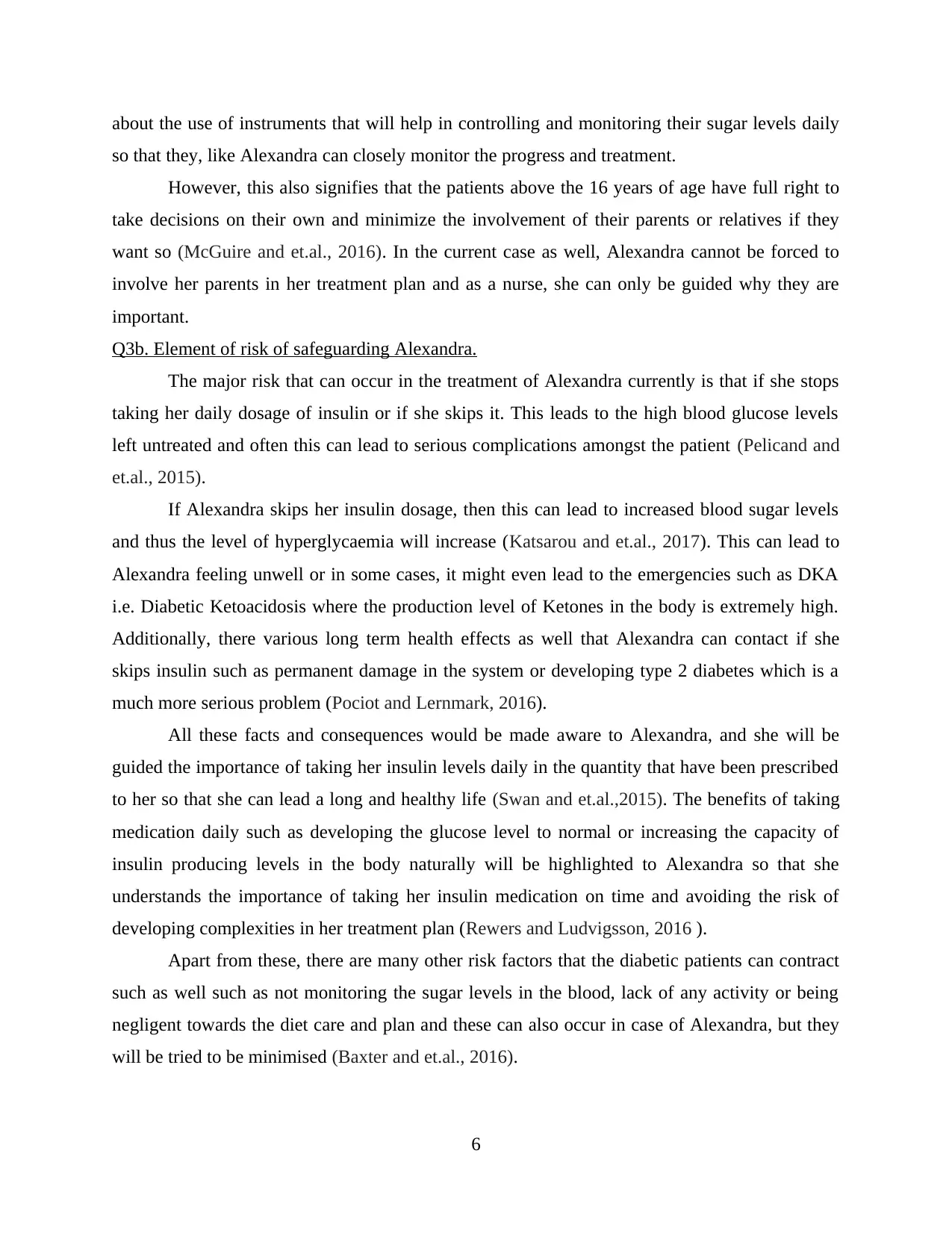
about the use of instruments that will help in controlling and monitoring their sugar levels daily
so that they, like Alexandra can closely monitor the progress and treatment.
However, this also signifies that the patients above the 16 years of age have full right to
take decisions on their own and minimize the involvement of their parents or relatives if they
want so (McGuire and et.al., 2016). In the current case as well, Alexandra cannot be forced to
involve her parents in her treatment plan and as a nurse, she can only be guided why they are
important.
Q3b. Element of risk of safeguarding Alexandra.
The major risk that can occur in the treatment of Alexandra currently is that if she stops
taking her daily dosage of insulin or if she skips it. This leads to the high blood glucose levels
left untreated and often this can lead to serious complications amongst the patient (Pelicand and
et.al., 2015).
If Alexandra skips her insulin dosage, then this can lead to increased blood sugar levels
and thus the level of hyperglycaemia will increase (Katsarou and et.al., 2017). This can lead to
Alexandra feeling unwell or in some cases, it might even lead to the emergencies such as DKA
i.e. Diabetic Ketoacidosis where the production level of Ketones in the body is extremely high.
Additionally, there various long term health effects as well that Alexandra can contact if she
skips insulin such as permanent damage in the system or developing type 2 diabetes which is a
much more serious problem (Pociot and Lernmark, 2016).
All these facts and consequences would be made aware to Alexandra, and she will be
guided the importance of taking her insulin levels daily in the quantity that have been prescribed
to her so that she can lead a long and healthy life (Swan and et.al.,2015). The benefits of taking
medication daily such as developing the glucose level to normal or increasing the capacity of
insulin producing levels in the body naturally will be highlighted to Alexandra so that she
understands the importance of taking her insulin medication on time and avoiding the risk of
developing complexities in her treatment plan (Rewers and Ludvigsson, 2016 ).
Apart from these, there are many other risk factors that the diabetic patients can contract
such as well such as not monitoring the sugar levels in the blood, lack of any activity or being
negligent towards the diet care and plan and these can also occur in case of Alexandra, but they
will be tried to be minimised (Baxter and et.al., 2016).
6
so that they, like Alexandra can closely monitor the progress and treatment.
However, this also signifies that the patients above the 16 years of age have full right to
take decisions on their own and minimize the involvement of their parents or relatives if they
want so (McGuire and et.al., 2016). In the current case as well, Alexandra cannot be forced to
involve her parents in her treatment plan and as a nurse, she can only be guided why they are
important.
Q3b. Element of risk of safeguarding Alexandra.
The major risk that can occur in the treatment of Alexandra currently is that if she stops
taking her daily dosage of insulin or if she skips it. This leads to the high blood glucose levels
left untreated and often this can lead to serious complications amongst the patient (Pelicand and
et.al., 2015).
If Alexandra skips her insulin dosage, then this can lead to increased blood sugar levels
and thus the level of hyperglycaemia will increase (Katsarou and et.al., 2017). This can lead to
Alexandra feeling unwell or in some cases, it might even lead to the emergencies such as DKA
i.e. Diabetic Ketoacidosis where the production level of Ketones in the body is extremely high.
Additionally, there various long term health effects as well that Alexandra can contact if she
skips insulin such as permanent damage in the system or developing type 2 diabetes which is a
much more serious problem (Pociot and Lernmark, 2016).
All these facts and consequences would be made aware to Alexandra, and she will be
guided the importance of taking her insulin levels daily in the quantity that have been prescribed
to her so that she can lead a long and healthy life (Swan and et.al.,2015). The benefits of taking
medication daily such as developing the glucose level to normal or increasing the capacity of
insulin producing levels in the body naturally will be highlighted to Alexandra so that she
understands the importance of taking her insulin medication on time and avoiding the risk of
developing complexities in her treatment plan (Rewers and Ludvigsson, 2016 ).
Apart from these, there are many other risk factors that the diabetic patients can contract
such as well such as not monitoring the sugar levels in the blood, lack of any activity or being
negligent towards the diet care and plan and these can also occur in case of Alexandra, but they
will be tried to be minimised (Baxter and et.al., 2016).
6
Paraphrase This Document
Need a fresh take? Get an instant paraphrase of this document with our AI Paraphraser

CONCLUSION
The proper diagnosis and treatment of the Alexandra has been developed and the role of
Nurse in her case was detailed and discussed in the report above. The impact of different
principles as per NMC Code and NICE guidelines on the treatment of patient with Type 1
diabetes was discussed and evaluated.
7
The proper diagnosis and treatment of the Alexandra has been developed and the role of
Nurse in her case was detailed and discussed in the report above. The impact of different
principles as per NMC Code and NICE guidelines on the treatment of patient with Type 1
diabetes was discussed and evaluated.
7
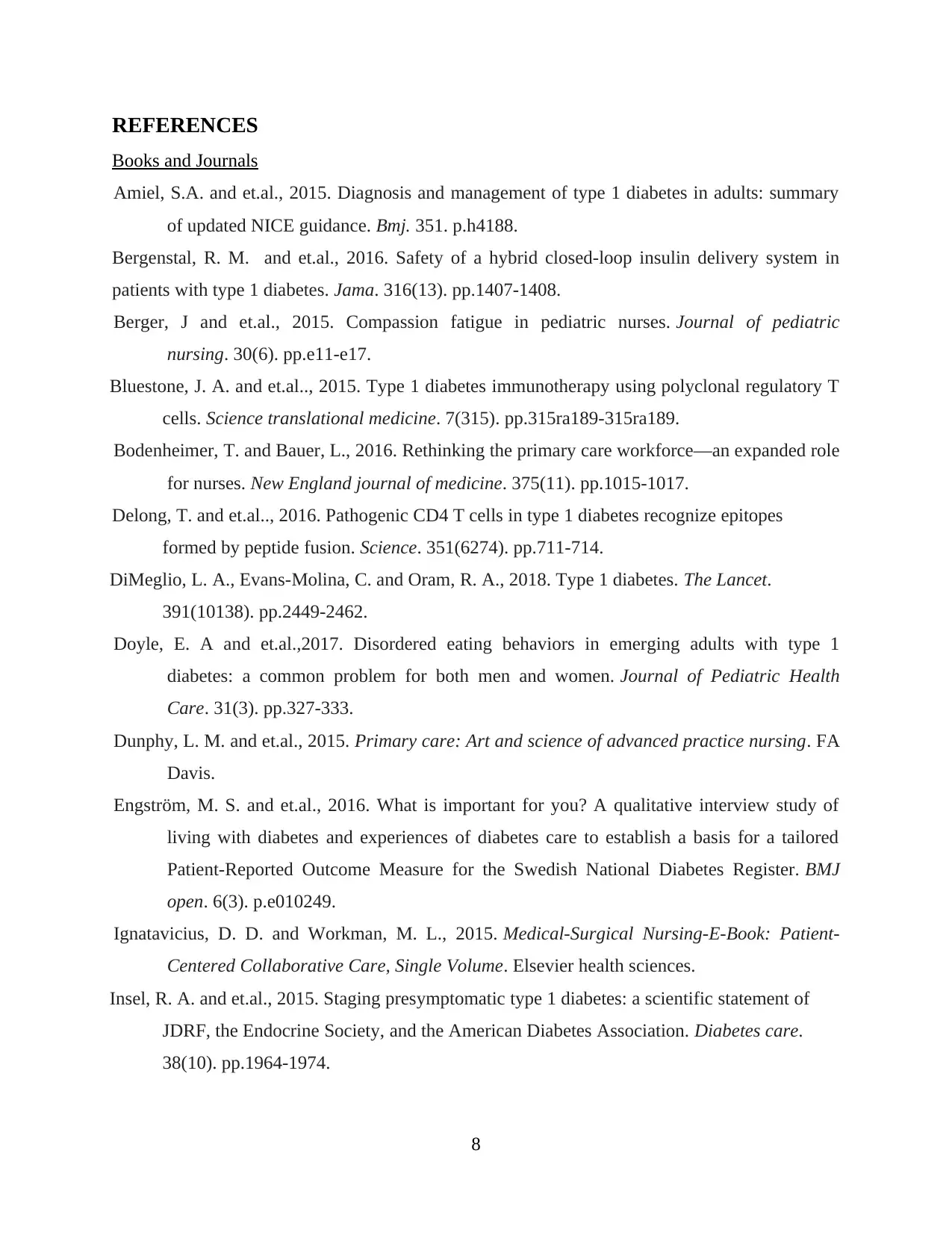
REFERENCES
Books and Journals
Amiel, S.A. and et.al., 2015. Diagnosis and management of type 1 diabetes in adults: summary
of updated NICE guidance. Bmj. 351. p.h4188.
Bergenstal, R. M. and et.al., 2016. Safety of a hybrid closed-loop insulin delivery system in
patients with type 1 diabetes. Jama. 316(13). pp.1407-1408.
Berger, J and et.al., 2015. Compassion fatigue in pediatric nurses. Journal of pediatric
nursing. 30(6). pp.e11-e17.
Bluestone, J. A. and et.al.., 2015. Type 1 diabetes immunotherapy using polyclonal regulatory T
cells. Science translational medicine. 7(315). pp.315ra189-315ra189.
Bodenheimer, T. and Bauer, L., 2016. Rethinking the primary care workforce—an expanded role
for nurses. New England journal of medicine. 375(11). pp.1015-1017.
Delong, T. and et.al.., 2016. Pathogenic CD4 T cells in type 1 diabetes recognize epitopes
formed by peptide fusion. Science. 351(6274). pp.711-714.
DiMeglio, L. A., Evans-Molina, C. and Oram, R. A., 2018. Type 1 diabetes. The Lancet.
391(10138). pp.2449-2462.
Doyle, E. A and et.al.,2017. Disordered eating behaviors in emerging adults with type 1
diabetes: a common problem for both men and women. Journal of Pediatric Health
Care. 31(3). pp.327-333.
Dunphy, L. M. and et.al., 2015. Primary care: Art and science of advanced practice nursing. FA
Davis.
Engström, M. S. and et.al., 2016. What is important for you? A qualitative interview study of
living with diabetes and experiences of diabetes care to establish a basis for a tailored
Patient-Reported Outcome Measure for the Swedish National Diabetes Register. BMJ
open. 6(3). p.e010249.
Ignatavicius, D. D. and Workman, M. L., 2015. Medical-Surgical Nursing-E-Book: Patient-
Centered Collaborative Care, Single Volume. Elsevier health sciences.
Insel, R. A. and et.al., 2015. Staging presymptomatic type 1 diabetes: a scientific statement of
JDRF, the Endocrine Society, and the American Diabetes Association. Diabetes care.
38(10). pp.1964-1974.
8
Books and Journals
Amiel, S.A. and et.al., 2015. Diagnosis and management of type 1 diabetes in adults: summary
of updated NICE guidance. Bmj. 351. p.h4188.
Bergenstal, R. M. and et.al., 2016. Safety of a hybrid closed-loop insulin delivery system in
patients with type 1 diabetes. Jama. 316(13). pp.1407-1408.
Berger, J and et.al., 2015. Compassion fatigue in pediatric nurses. Journal of pediatric
nursing. 30(6). pp.e11-e17.
Bluestone, J. A. and et.al.., 2015. Type 1 diabetes immunotherapy using polyclonal regulatory T
cells. Science translational medicine. 7(315). pp.315ra189-315ra189.
Bodenheimer, T. and Bauer, L., 2016. Rethinking the primary care workforce—an expanded role
for nurses. New England journal of medicine. 375(11). pp.1015-1017.
Delong, T. and et.al.., 2016. Pathogenic CD4 T cells in type 1 diabetes recognize epitopes
formed by peptide fusion. Science. 351(6274). pp.711-714.
DiMeglio, L. A., Evans-Molina, C. and Oram, R. A., 2018. Type 1 diabetes. The Lancet.
391(10138). pp.2449-2462.
Doyle, E. A and et.al.,2017. Disordered eating behaviors in emerging adults with type 1
diabetes: a common problem for both men and women. Journal of Pediatric Health
Care. 31(3). pp.327-333.
Dunphy, L. M. and et.al., 2015. Primary care: Art and science of advanced practice nursing. FA
Davis.
Engström, M. S. and et.al., 2016. What is important for you? A qualitative interview study of
living with diabetes and experiences of diabetes care to establish a basis for a tailored
Patient-Reported Outcome Measure for the Swedish National Diabetes Register. BMJ
open. 6(3). p.e010249.
Ignatavicius, D. D. and Workman, M. L., 2015. Medical-Surgical Nursing-E-Book: Patient-
Centered Collaborative Care, Single Volume. Elsevier health sciences.
Insel, R. A. and et.al., 2015. Staging presymptomatic type 1 diabetes: a scientific statement of
JDRF, the Endocrine Society, and the American Diabetes Association. Diabetes care.
38(10). pp.1964-1974.
8
⊘ This is a preview!⊘
Do you want full access?
Subscribe today to unlock all pages.

Trusted by 1+ million students worldwide

Katsarou, A. and et.al., 2017. Type 1 diabetes mellitus. Nature reviews Disease primers. 3.
p.17016.
Lawton, J. and et.al., 2015. Uncovering the emotional aspects of working on a clinical trial: a
qualitative study of the experiences and views of staff involved in a type 1 diabetes
trial. Trials. 16(1). p.3.
Livanos, A. E. and et.al.., 2016. Antibiotic-mediated gut microbiome perturbation accelerates
development of type 1 diabetes in mice. Nature microbiology. 1(11). p.16140.
Livingstone, S. J. and et.al., 2015. Estimated life expectancy in a Scottish cohort with type 1
diabetes, 2008-2010. Jama. 313(1). pp.37-44.
McEwan, P. and et.al., 2018. Assessing the economic value of maintained improvements in Type
1 diabetes management, in terms of HbA1c, weight and hypoglycaemic event
incidence. Diabetic Medicine. 35(5). pp.557-566.
McKnight, J. A. and et.al., 2015. Glycaemic control of Type 1 diabetes in clinical practice early
in the 21st century: an international comparison. Diabetic Medicine. 32(8). pp.1036-1050.
Miller, K. M. and et.al., 2015. Current state of type 1 diabetes treatment in the US: updated data
from the T1D Exchange clinic registry. Diabetes care. 38(6). pp.971-978.
Millman, J. R. and et.al., 2016. Generation of stem cell-derived β-cells from patients with type 1
diabetes. Nature communications. 7. p.11463.
Morris, D., 2016. NICE guideline on type 1 diabetes. Independent Nurse. 2016(8). pp.18-22.
Onengut-Gumuscu, S. and et.al., 2015. Fine mapping of type 1 diabetes susceptibility loci and
evidence for colocalization of causal variants with lymphoid gene enhancers. Nature
genetics. 47(4). p.381.
Pelicand, J. and et.al., 2015. Self‐care support in paediatric patients with type 1 diabetes:
bridging the gap between patient education and health promotion? A review. Health
Expectations. 18(3). pp.303-311.
Pociot, F. and Lernmark, Å., 2016. Genetic risk factors for type 1 diabetes. The
Lancet. 387(10035). pp.2331-2339.
Reddy, M. and et.al., 2016. Type 1 diabetes in adults: supporting self management. Bmj. 352.
p.i998.
Rewers, M. and Ludvigsson, J., 2016. Environmental risk factors for type 1 diabetes. The
Lancet. 387(10035). pp.2340-2348.
9
p.17016.
Lawton, J. and et.al., 2015. Uncovering the emotional aspects of working on a clinical trial: a
qualitative study of the experiences and views of staff involved in a type 1 diabetes
trial. Trials. 16(1). p.3.
Livanos, A. E. and et.al.., 2016. Antibiotic-mediated gut microbiome perturbation accelerates
development of type 1 diabetes in mice. Nature microbiology. 1(11). p.16140.
Livingstone, S. J. and et.al., 2015. Estimated life expectancy in a Scottish cohort with type 1
diabetes, 2008-2010. Jama. 313(1). pp.37-44.
McEwan, P. and et.al., 2018. Assessing the economic value of maintained improvements in Type
1 diabetes management, in terms of HbA1c, weight and hypoglycaemic event
incidence. Diabetic Medicine. 35(5). pp.557-566.
McKnight, J. A. and et.al., 2015. Glycaemic control of Type 1 diabetes in clinical practice early
in the 21st century: an international comparison. Diabetic Medicine. 32(8). pp.1036-1050.
Miller, K. M. and et.al., 2015. Current state of type 1 diabetes treatment in the US: updated data
from the T1D Exchange clinic registry. Diabetes care. 38(6). pp.971-978.
Millman, J. R. and et.al., 2016. Generation of stem cell-derived β-cells from patients with type 1
diabetes. Nature communications. 7. p.11463.
Morris, D., 2016. NICE guideline on type 1 diabetes. Independent Nurse. 2016(8). pp.18-22.
Onengut-Gumuscu, S. and et.al., 2015. Fine mapping of type 1 diabetes susceptibility loci and
evidence for colocalization of causal variants with lymphoid gene enhancers. Nature
genetics. 47(4). p.381.
Pelicand, J. and et.al., 2015. Self‐care support in paediatric patients with type 1 diabetes:
bridging the gap between patient education and health promotion? A review. Health
Expectations. 18(3). pp.303-311.
Pociot, F. and Lernmark, Å., 2016. Genetic risk factors for type 1 diabetes. The
Lancet. 387(10035). pp.2331-2339.
Reddy, M. and et.al., 2016. Type 1 diabetes in adults: supporting self management. Bmj. 352.
p.i998.
Rewers, M. and Ludvigsson, J., 2016. Environmental risk factors for type 1 diabetes. The
Lancet. 387(10035). pp.2340-2348.
9
Paraphrase This Document
Need a fresh take? Get an instant paraphrase of this document with our AI Paraphraser
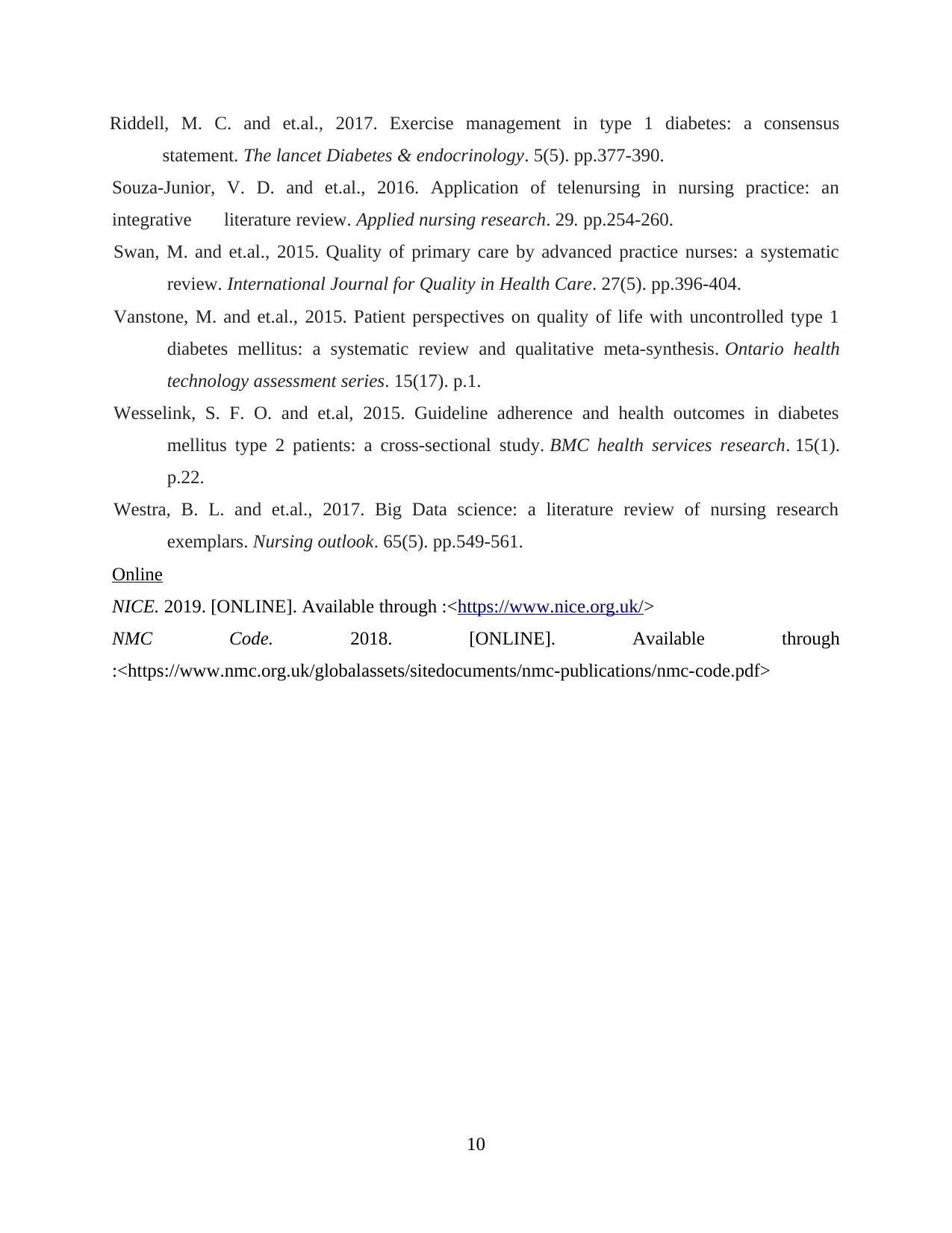
Riddell, M. C. and et.al., 2017. Exercise management in type 1 diabetes: a consensus
statement. The lancet Diabetes & endocrinology. 5(5). pp.377-390.
Souza-Junior, V. D. and et.al., 2016. Application of telenursing in nursing practice: an
integrative literature review. Applied nursing research. 29. pp.254-260.
Swan, M. and et.al., 2015. Quality of primary care by advanced practice nurses: a systematic
review. International Journal for Quality in Health Care. 27(5). pp.396-404.
Vanstone, M. and et.al., 2015. Patient perspectives on quality of life with uncontrolled type 1
diabetes mellitus: a systematic review and qualitative meta-synthesis. Ontario health
technology assessment series. 15(17). p.1.
Wesselink, S. F. O. and et.al, 2015. Guideline adherence and health outcomes in diabetes
mellitus type 2 patients: a cross-sectional study. BMC health services research. 15(1).
p.22.
Westra, B. L. and et.al., 2017. Big Data science: a literature review of nursing research
exemplars. Nursing outlook. 65(5). pp.549-561.
Online
NICE. 2019. [ONLINE]. Available through :<https://www.nice.org.uk/>
NMC Code. 2018. [ONLINE]. Available through
:<https://www.nmc.org.uk/globalassets/sitedocuments/nmc-publications/nmc-code.pdf>
10
statement. The lancet Diabetes & endocrinology. 5(5). pp.377-390.
Souza-Junior, V. D. and et.al., 2016. Application of telenursing in nursing practice: an
integrative literature review. Applied nursing research. 29. pp.254-260.
Swan, M. and et.al., 2015. Quality of primary care by advanced practice nurses: a systematic
review. International Journal for Quality in Health Care. 27(5). pp.396-404.
Vanstone, M. and et.al., 2015. Patient perspectives on quality of life with uncontrolled type 1
diabetes mellitus: a systematic review and qualitative meta-synthesis. Ontario health
technology assessment series. 15(17). p.1.
Wesselink, S. F. O. and et.al, 2015. Guideline adherence and health outcomes in diabetes
mellitus type 2 patients: a cross-sectional study. BMC health services research. 15(1).
p.22.
Westra, B. L. and et.al., 2017. Big Data science: a literature review of nursing research
exemplars. Nursing outlook. 65(5). pp.549-561.
Online
NICE. 2019. [ONLINE]. Available through :<https://www.nice.org.uk/>
NMC Code. 2018. [ONLINE]. Available through
:<https://www.nmc.org.uk/globalassets/sitedocuments/nmc-publications/nmc-code.pdf>
10
1 out of 11
Related Documents
Your All-in-One AI-Powered Toolkit for Academic Success.
+13062052269
info@desklib.com
Available 24*7 on WhatsApp / Email
![[object Object]](/_next/static/media/star-bottom.7253800d.svg)
Unlock your academic potential
Copyright © 2020–2025 A2Z Services. All Rights Reserved. Developed and managed by ZUCOL.





